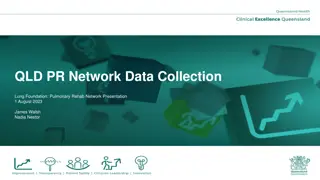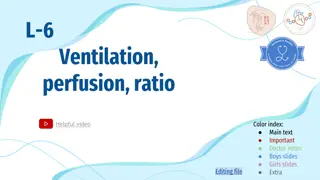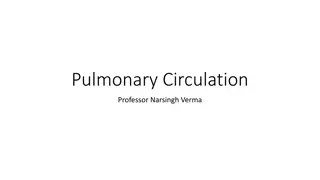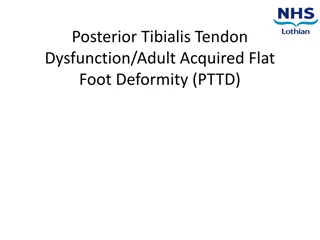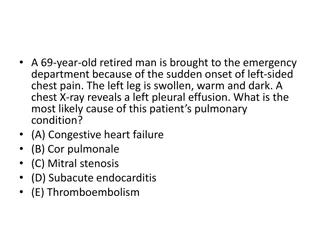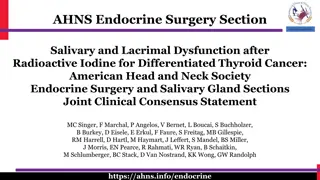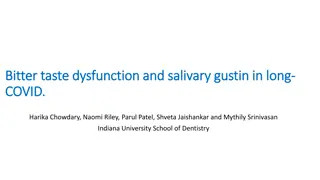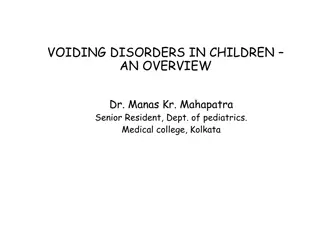UK Survey on Endovascular Treatment of Acute Pulmonary Embolism
Acute pulmonary embolism (PE) is a significant issue in hospitalized patients, with current treatments focusing on anticoagulation and systemic thrombolysis. Surgical treatments have shown poor outcomes, leading to a rise in endovascular techniques aimed at reducing clot burden. A survey conducted i
0 views • 12 slides
Pulmonary and Critical Care Lecture Highlights: Bronchiectasis and Sarcoidosis Overview
Dive into the realm of pulmonary and critical care as Dr. Michael Forte discusses the intricacies of bronchiectasis and sarcoidosis. Understand the etiologies, diagnosis, investigations, and treatment options for these respiratory conditions. Explore the challenges and nuances of managing patients w
0 views • 35 slides
Radiographic Imaging Methods of the Respiratory System
Radiographic imaging plays a crucial role in the evaluation and diagnosis of thoraco-mediastino-pleuro-pulmonary conditions. Techniques like radioscopy, digital radiography, computer tomography, magnetic resonance imaging, conventional pulmonary angiography, and hybrid imaging methods offer detailed
10 views • 21 slides
Statewide Pulmonary Rehabilitation Project Overview
The Statewide Pulmonary Rehabilitation Project, funded by Clinical Excellence Queensland, aims to enhance care models for chronic lung diseases like COPD and asthma. The project explores virtual rehabilitation integration, ensuring equity and improved access for patients. Challenges include resource
4 views • 21 slides
Echocardiographic Assessment of Pulmonary Arterial Hypertension (PAH) Overview
Echocardiographic assessment plays a crucial role in the diagnosis, management, and prognostic evaluation of pulmonary arterial hypertension (PAH). This condition is characterized by elevated mean pulmonary arterial pressure and pulmonary vascular resistance, leading to various clinical features suc
6 views • 43 slides
Understanding Pulmonary Circulation and V/Q Ratio in Respiratory Physiology
Explore the high-pressure and low-pressure circulations supplying the lungs, the concept of physiological shunt in pulmonary circulation, different lung zones based on blood flow, V/Q ratio and its clinical significance, and abnormal V/Q ratio patterns. Delve into the role of pulmonary circulations
11 views • 28 slides
Cystic Fibrosis:The Modulator Era
Cystic Fibrosis (CF) is a genetic disease caused by variants in the CFTR gene. CFTR is a crucial membrane protein responsible for chloride transport in epithelial cells, impacting organ function. The Modulator Era focuses on CFTR modulators approved by the FDA for treating CF and improving outcomes.
0 views • 63 slides
Understanding Pulmonary Circulation and Its Importance in Respiratory Physiology
Pulmonary circulation, as explained by Professor Narsingh Verma, plays a crucial role in the respiratory system, showcasing distinct differences from systemic circulation. The low pressure and resistance in pulmonary circulation allow for optimal gas exchange at the alveolocapillary membrane. Variou
1 views • 30 slides
Comprehensive Overview of Pulmonary Function Tests (PFTs)
Pulmonary Function Tests (PFTs) are vital for assessing pulmonary gas exchange through ventilation, diffusion, and lung perfusion. These tests include measurements of lung volume, airway patency, gas exchange efficacy, and pulmonary blood flow. PFTs offer benefits in diagnosing dyspnea, monitoring d
0 views • 14 slides
Understanding Posterior Tibialis Tendon Dysfunction (PTTD) in Adults
Posterior Tibialis Tendon Dysfunction, also known as Adult Acquired Flat Foot Deformity (PTTD), is a condition that affects the tibialis posterior tendon, leading to reduced arch support. Common causes include obesity, trauma, age, and existing health conditions. Symptoms may include ankle pain, swe
0 views • 12 slides
Understanding Chronic Obstructive Pulmonary Diseases (COPD) and Emphysema
Chronic Obstructive Pulmonary Diseases (COPD) encompass conditions like chronic bronchitis and emphysema, typically caused by factors like cigarette smoking. This presentation delves into the clinical and functional variances between chronic bronchitis and emphysema in COPD patients, along with an e
1 views • 40 slides
Case Report: Submassive Bilateral Pulmonary Embolism in a 69-Year-Old Female
Anne Knisely, a 69-year-old female with a history of endometrial cancer, presented with left leg pain, pleuritic chest pain, and shortness of breath. Imaging revealed extensive bilateral pulmonary emboli, right heart strain, and lower extremity deep vein thrombi. She was managed with anticoagulation
3 views • 11 slides
Understanding Sexual Dysfunction and Associated Factors
Sexual dysfunction encompasses a range of issues that can affect individuals, with causes including psychological, neurological, hormonal, and relationship-related factors. Evaluating sexual problems involves considering duration, context, and frequency. Psychological causes, such as anxiety and str
0 views • 25 slides
Understanding Sacroiliac Joint Dysfunction: A Comprehensive Guide
Discover the intricate anatomy of the spine, learn about the prevalence and causes of lower back pain, delve into the symptoms and diagnosis of sacroiliac joint dysfunction, and explore treatment options to manage this condition effectively.
0 views • 27 slides
Understanding Hantavirus Pulmonary Syndrome: Diagnosis and Clinical Review
This content provides an in-depth overview of Hantavirus Pulmonary Syndrome, including its clinical presentation, diagnosis, and management. It covers key points such as incubation periods, symptoms, and diagnostic tests like ELISA. The information emphasizes the need for a high index of suspicion d
0 views • 24 slides
Understanding the Importance of Breathing Exercises in Respiratory Management
Breathing exercises, also known as ventilatory training, play a crucial role in improving pulmonary status, enhancing endurance, and increasing overall functionality in daily activities. These exercises help retrain respiratory muscles, improve ventilation, reduce breathing effort, enhance gas excha
0 views • 32 slides
Pulmonary Rehabilitation: Benefits of a 12-Week Program - One Year Follow-Up
This study focuses on the benefits obtained from a 12-week pulmonary rehabilitation program with a one-year follow-up. The program includes scientifically based diagnostic management, multidisciplinary approach, exercise, and education. A baseline assessment was conducted before enrollment, and pati
0 views • 23 slides
Pulmonary Conditions and Hemodynamic Disorders: Clinical Cases
A 69-year-old man with chest pain and pleural effusion presents with thromboembolism; a 22-year-old worker with fractures develops shock due to fat embolism; a postpartum woman dies from amniotic fluid embolism. The cases illustrate conditions like pulmonary embolism, fat embolism, and amniotic flui
0 views • 26 slides
Chronic Obstructive Pulmonary Disease (COPD) in Horses: A Veterinarian's Perspective
Chronic Obstructive Pulmonary Disease (COPD) in horses is a respiratory condition caused by hypersensitivity reactions to allergens, viral infections, or bronchopneumonia. This chronic respiratory disease leads to decreased work performance, chronic coughing, abnormal lung sounds, and cardiac dysfun
0 views • 17 slides
Pulmonary Hydrotherapy: Innovation in Exercise for COPD Patients
Pulmonary hydrotherapy is being explored as a safe and effective form of exercise for COPD patients, challenging previous beliefs about water-based activities. South Tees Pulmonary Rehabilitation Service is examining the benefits of hydrotherapy in improving exercise capacity and quality of life, ba
1 views • 10 slides
Understanding Movement Dysfunction in Sports Medicine
Movement dysfunction in sports medicine can stem from various factors such as structural instability, loss of range of motion, functional rigidity, poor balance, and more. Clinical movement analysis plays a vital role in identifying muscle imbalances and guiding exercise interventions to enhance ath
0 views • 21 slides
Clinical Judgement Test: Neonatal Foal Case Presentation and Assessment
This case involves a clinical judgement test scenario of an 8-hour-old Standardbred colt foal presenting with recumbency, weakness, and abnormal blood parameters. The foal's history suggests possible placental insufficiency and dysmaturity, leading to pulmonary dysfunction and other complications. I
0 views • 14 slides
Understanding Executive Functioning and Executive Dysfunction
Executive Functioning is a key aspect of cognitive function, encompassing various abilities such as planning, self-awareness, and emotion regulation. Executive Dysfunction, often resulting from frontal lobe injuries, can lead to difficulties in decision-making, social interactions, and learning. Thi
1 views • 21 slides
Understanding Ion Channel Dysfunction in Critical Illness
An intriguing case study presents a young male with weakness and coma in the ICU following pneumonia and sepsis. Nerve conduction results indicated critical illness myopathy and polyneuropathy, along with cardiac abnormalities. Reduced muscle excitability was attributed to a sodium channelopathy. Th
0 views • 14 slides
Understanding Vocal Fold Paralysis and Neural Dysfunction After Thyroid and Parathyroid Surgery
This consensus statement by the American Head and Neck Society Endocrine Surgery Section highlights the importance of recognizing immediate vocal fold paralysis (VFP) and partial neural dysfunction (PND) following thyroid and parathyroid surgery. The report emphasizes the need for early identificati
0 views • 17 slides
Addressing Cognitive Dysfunction in Patients with Cancer: Causes, Impact, and Treatment
Understanding cognitive dysfunction in cancer patients is crucial for improving quality of life and medical outcomes. This article explores the background, causes, screening, diagnosis, and treatment options for cancer-related cognitive impairment, emphasizing the historical perspective, prevalence,
0 views • 60 slides
Postural Drainage Therapy for Airway Clearance
Postural drainage therapy is an intervention used for airway clearance by mobilizing secretions in specific lung segments towards the central airways. It involves placing the patient in various positions to facilitate gravity-assisted drainage. The therapy includes manual techniques such as percussi
0 views • 13 slides
Understanding Cardiovascular Complications of Thalassaemia
Cardiovascular complications of thalassaemia can be categorized into iron overload-related issues such as myocyte failure and arrhythmias, and non-iron overload complications including pulmonary hypertension and atrial fibrillation. Cardiac iron accumulation poses a significant risk, leading to card
0 views • 36 slides
Exploring the Diverse Applications of PDE-5 Inhibitors Beyond Erectile Dysfunction
Discover how PDE-5 inhibitors go beyond treating erectile dysfunction, with approved and emerging compounds, alternative dose regimens, concentration sites, and potential targets like cardiovascular diseases and the central nervous system.
0 views • 47 slides
Understanding Shock: Causes, Phases, and Pathophysiology
This comprehensive guide delves into the various aspects of shock, including hypovolemia, pulmonary embolism, and acute myocardial infarction. It covers the general concept of shock, circulatory failure, phases of shock, pathophysiology, manifestations, diagnostic approaches, and complications such
0 views • 52 slides
Understanding Haemodynamic Consequences of Acute Pulmonary Embolism
Haemodynamic consequences of acute pulmonary embolism (PE) include increased mean pulmonary artery pressure, rise in right ventricular preload and end-diastolic pressure, risk of right ventricular failure, and decreased pulmonary blood flow leading to low systolic blood pressure. Arterial hypoxia ca
0 views • 18 slides
Understanding Pulmonary Arterial Hypertension (PAH): Causes, Symptoms, and Management
Pulmonary Arterial Hypertension (PAH) is a progressive disease characterized by increased blood pressure in the pulmonary artery, veins, or capillaries. This condition can lead to right ventricular failure and eventual death if left untreated. PAH can have various causes, including idiopathic factor
0 views • 49 slides
Salivary and Lacrimal Dysfunction after Radioactive Iodine Treatment
Radioactive iodine (RAI) is commonly used in treating differentiated thyroid cancer but can lead to salivary and lacrimal dysfunction. This joint clinical consensus statement by the American Head and Neck Society Endocrine Surgery and Salivary Gland Sections highlights the importance of understandin
0 views • 20 slides
Understanding the MMPI-2-RF Substantive Scales for Mental Disorder Assessment
This research explores mapping the MMPI-2-RF substantive scales onto internalizing, externalizing, and thought dysfunction dimensions in mental health assessment. The study emphasizes the importance of validating assessments for accurate clinical pictures and effective treatment planning. It delves
0 views • 17 slides
Understanding Pelvic Floor Dysfunction and Prolapse in Women
Pelvic floor dysfunction and prolapse are common issues affecting women, impacting their physical and emotional well-being. Surgical treatment may be necessary for symptomatic cases, but a thorough evaluation of symptoms, obstetric history, and other factors is crucial. Addressing precipitating fact
0 views • 72 slides
Overview of Pulmonary Hemorrhage in Infants
Pulmonary hemorrhage in infants is a severe condition characterized by bloody discharge from the upper respiratory tract or endotracheal tube, often associated with prematurity, lung complications, infections, or trauma. The etiology, pathophysiology, clinical manifestations, and diagnosis of pulmon
0 views • 14 slides
Understanding Cardiorenal Syndrome: A Complex Relationship Between the Heart and Kidneys
Cardiorenal Syndrome is a condition where dysfunction in one organ, whether acute or chronic, can lead to dysfunction in the other. This complex relationship involves intricate communication pathways between the heart and kidneys, impacting hemodynamic stability, organ perfusion, and neurohormonal i
0 views • 15 slides
Salivary Gustin and Taste Dysfunction in Long-COVID Patients
The research explores the association between taste perception and the duration of COVID infection in long-COVID and COVID-reinfection cases. Reduced salivary gustin levels correlated with lower taste scores in long-COVID patients. The study also found an increase in the bitter taste receptor gene e
1 views • 4 slides
Understanding Primary Ovarian Insufficiency: Definition, Pathophysiology, Clinical Features
Primary ovarian insufficiency, also known as hypergonadotropic amenorrhea, is a condition characterized by ovarian dysfunction in women under 40. It involves oligo/amenorrhea, elevated FSH levels, and impacts fertility and overall health. The pathophysiology includes follicle depletion and dysfuncti
0 views • 46 slides
Understanding Voiding Disorders in Children: An Overview by Dr. Manas Kr. Mahapatra
Voiding disorders in children, also known as bladder dysfunction, are a common issue affecting up to 40% of pediatric urology clinic visits. These disorders can indicate underlying pathophysiology requiring treatment to prevent renal or urologic damage. The development of urinary control by age 5 is
0 views • 53 slides



